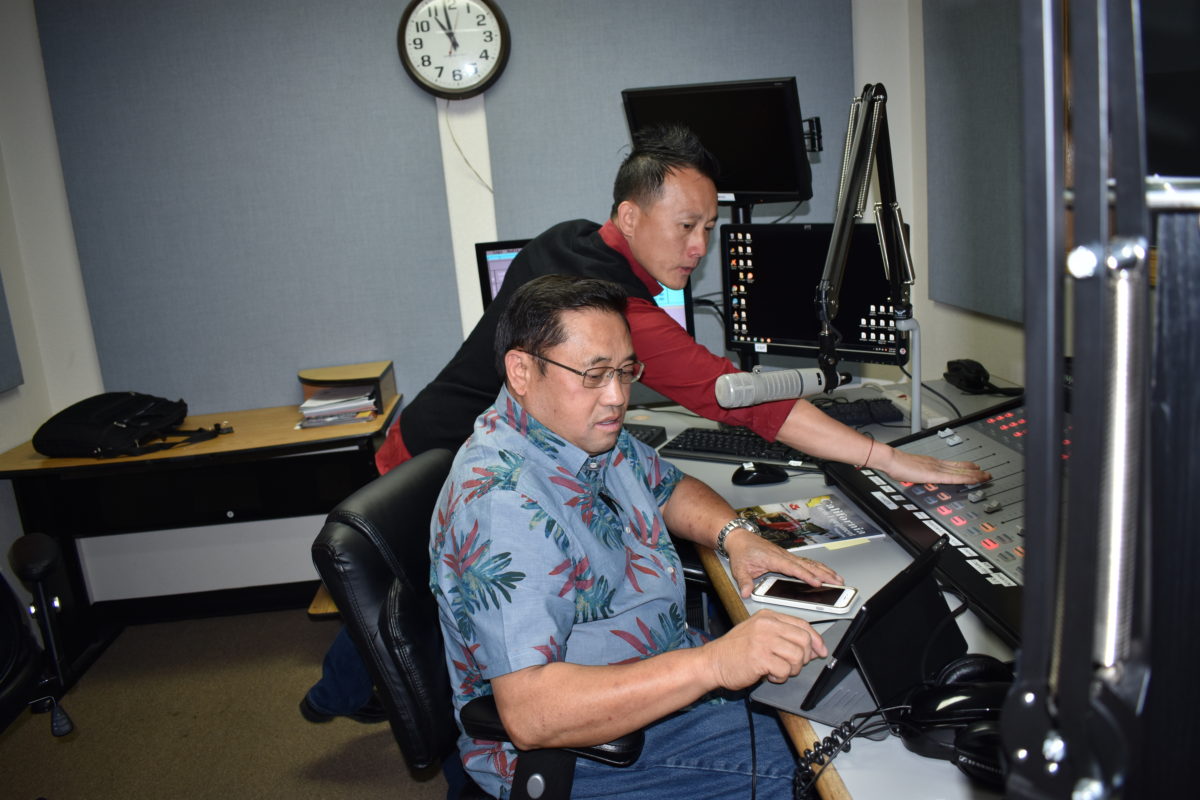
Sam Vang sits at the mic while Moua Vang checks the controls. Sam Vang works with the USDA and hosts a radio program with KBIF 900 AM where he talks about assets and programs, along with farming techniques that Asian-American growers can use. Through Facebook, his show has even reached farmers back home in Laos. Photo by Donald A. Promnitz.
Hmong-American farmer Sam Vang joined the U.S. Department of Agriculture after his farm went under in the late ‘90s. Today, he takes to the airwaves to advise farmers in the Asian-American community.
As a part of the USDA, his show, which airs on KBIF 900 AM in the morning, informs growers about the different programs and assets available to them. They also advise them on different techniques to better aid in crop production.
“The most important part is how they can farm here because with the farming background they brought with them, well, it may work back in the old country, but probably not here,” Vang said.
Alongside their English counterparts, there are numerous stations in the region broadcasting in a foreign language. Spanish is the most common, having more than a dozen stations in the Valley. For thousands of residents, these stations can provide not only a familiar language, but also a crucial link to the broader community.
Located in Fresno, KBIF 900 AM has a signal that runs from Modesto to Bakersfield. Tony Donato, the general and operations manager for KBIF, said that as such, the station plays an important role in the Hmong community by keeping them informed and connected.
While doing Punjabi programming since 1987, Donato said that it was in the early ‘90s that the station embraced the foreign-language format. From there, KBIF zeroed in on the quickly growing Hmong population. Initially, it was only for a few hours a night, with Christian broadcasting being the main focus. Later, they diversified their programming and expanded their audience.
“We were getting a lot of listeners tuning into us at night,” Donato said. “So we started slowly moving programming earlier in the day.”
Today, their format includes news, entertainment and public service broadcasts for multiple languages spanning older and younger generations. This has also included broadcasting to help save lives, as it did when there was an epidemic of suicides with young Hmong in the early 2000s.
“The parents are more traditional, but the younger generations are more modern,” said program director Moua Vang. “So there was a conflict between the parents and the kids, so at that time, there were a lot of cases of suicide.”
This prompted KBIF to include “Gen X” programming, with contemporary music and shows.
Another aspect of foreign language radio, meanwhile, has been community involvement. This has been the goal of Fresno Realtor Gurdeep Shergill’s Saturday morning show.
“My thing is people need to know what’s going on,” Shergill said. “We’re not just that community that’s hidden — we have to be on the mainstream. That’s important, and that’s been happening.”
An active member of the Punjabi community in Fresno, Shergill expressed his concern about Indian-American involvement in not only their groups, but in the Central Valley at large. During the primaries, Shergill also interviewed a number of candidates running for office, including city council and judgeship hopefuls.
Far from becoming insular, Shergill said that Valley Punjabis have taken major steps to become involved. To this, he pointed to the recent changing of Victoria West Community Park’s name to honor Sikh human rights activist Jaswant Singh Khalra.
Running a foreign language radio format, however, is not without its challenges. Difficulty can be found in getting listeners when a specific demographic is targeted. There can be further hurdles in getting advertisers to invest in airtime, though KBIF has found an advantage in this area by being the only Asian radio station in the Central Valley.
Fresno alone has a Hmong population of more than 23,000 people according to a 2010 census. According to Donato 90 to 95 percent of this population tunes into KBIF at some point, giving them the ability use the population as incentive for advertisement, as they can serve as a window.
While this system has proven effective, it also means challenges in translation. Commercials frequently come with slang terms and words that don’t exist in the Hmong vocabulary. This means that the writers have to come up with ways to write it out in a way that fits the 60-second time frame.
“We just did one for the three-day watering campaign and they don’t have a word for ‘sprinkler,’ Donato said. “You just say it.”
The issues faced, however, are worthwhile according to those who work in the stations, as they help those who might otherwise stay in the shadows.
“We don’t want to be segregated,” he said. “It’s all about the melting pot, the diversity.”








